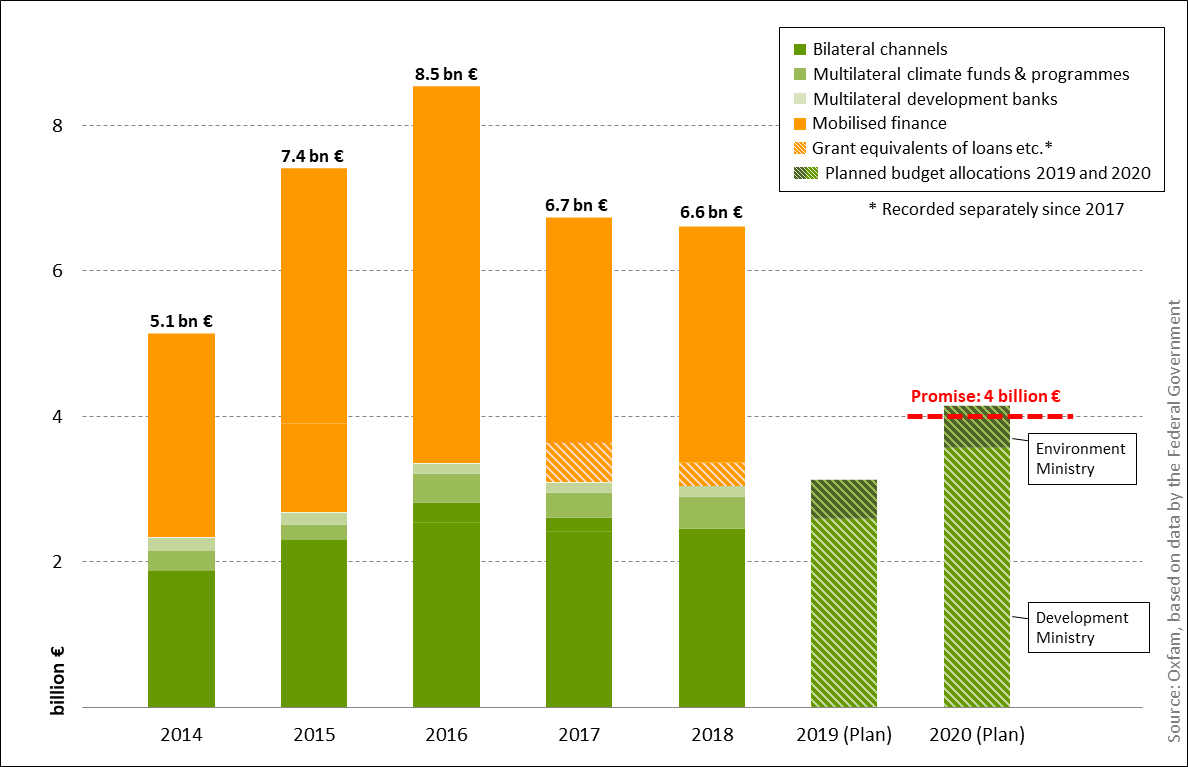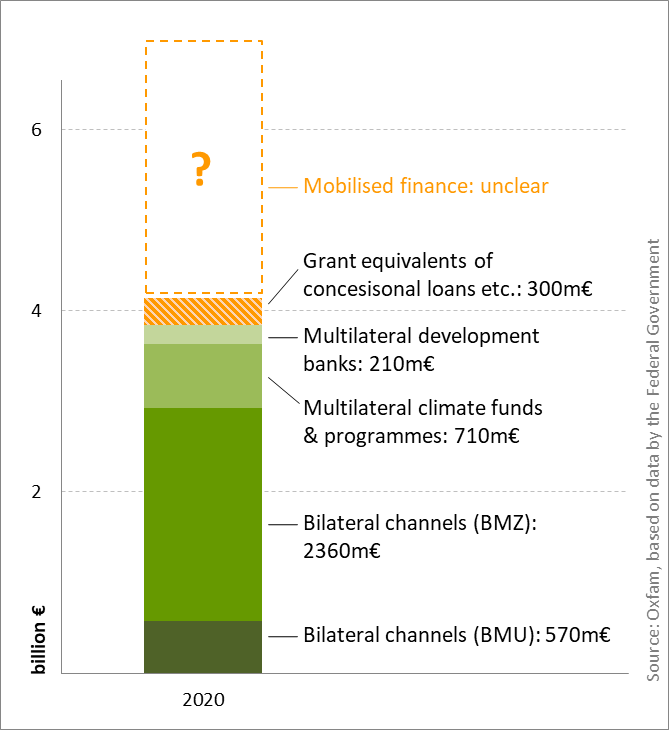100 billion / Federal budget / German climate finance / UNFCCC
German climate finance: state of play and 2020 challenges
In the past, Germany has been among the more ambitious providers of financial assistance to developing countries’ efforts to adapt to a changing climate and cut or avoid greenhouse gas emissions. Germany was the first country to pledge to the Green Climate Fund both for the initial capitalisation in 2014 as well as for the first formal replenishment of the fund in 2019, putting other rich countries under pressure. Back in 2015, half a year before the adoption of the Paris Agreement, German chancellor Angela Merkel promised to double German climate finance, aiming for around 4 billion Euros in budgetary allocations in 2020, again challenging other countries to follow suit and generating positive momentum ahead of the Paris summit.
Shrinking climate finance budgets 2017 and 2018
Following that promise, German climate finance reached a maximum in 2016, with around 3.4 billion Euros from the federal budget plus around 5.2 billion Euros in mobilised finance (see box). 2017 then saw a steep decline, and also in 2018 climate finance decreased further. 2019 final figures are not available yet but budget plans had foreseen only a tiny increase over 2018.
2020: Steep increase to meet the Merkel promise
For 2020, the situation may now change for the better. With the adoption of the 2020 federal budget late last year, Angela Merkel may actually be able to fulfil her promise, as internal budget allocations aim for around 4.1 billion Euros in 2020 – plus a yet-unspecified amount of mobilised finance (i.e. loans and other non-grant instruments minus their grant-equivalent). The combined total, one can assume, is what the government considers an adequate German contribution to the goal set by developed countries to ramp up climate finance to 100 billion US-Dollars a year by 2020.
Initially, the early stages of the parliamentary process to adopt Germany’s 2020 federal budget revealed that the promise was all but secure. The first budget proposed by the government coalition in spring 2019 to parliament included a gap of around 500 million Euros – but, eventually, the prospect of an embarrassing revelation at COP25 finally convinced the finance minister to concede the additional funds.
Most of the funds will come from the development ministry, with nearly 2.4 billion Euros allocated for bilateral, climate-related development programmes. Around 710 million Euros will be provided to multilateral climate funds and other multilateral programmes or initiatives, with the single biggest beneficiary being the Green Climate Fund that will receive nearly 200 million Euros in 2020 (the combined total of one instalment from Germany’s initial GCF pledge in 2014 and another one from its first formal pledge in 2019). As in the past, also the Least Developed Countries Fund, the Forest Carbon Partnership Facility and several other funds and programmes will receive contributions. The International Climate Initiative of the Environment Ministry (BMU) will be able to contribute 570 million Euros to bilateral projects, more than ever before.
| Mobilised Finance |
|
In reporting climate finance, e.g. in its Biennial Reports to the UNFCCC, Germany distinguishes between finance from budgetary sources and mobilised finance. The former includes bilateral grants, interest subsidies to make loans concessional, contributions to multilateral climate funds and payments to the multilateral development banks (proportional to their climate-related spending). ‘Mobilised finance’, in contrast, is a computed figure, consisting of the face-value of non-grant instruments such as loans or equity, for which the German development bank KfW and its subsidiary DEG raises finance from the capital markets (hence the term ‘mobilised finance’), minus their grant equivalent e.g. in the case of concessional loans. The combined grant-equivalents of all concessional loans are then listed as lump-sums under the first category (finance from budgetary sources). While grant-equivalents are of course not part of the budgetary allocations, this accounting method allows for a much better understanding of the net financial value that gets transferred to developing countries under German climate finance. |
Challenges ahead
While the signs on climate finance from Germany look promising for 2020 (save for an accounting trick that means the doubling isn’t an actual doubling of the initial baseline underpinning Merkel’s promise, see here), there are a number of challenges ahead that the German government should tackle now. Among them are the following five:
1. 100-billion goal: 2020 is the year where climate finance is to reach a level of 100 billion US-Dollars a year. While official reporting on provided financial assistance in 2020 is due only a couple of years from now, Germany and the other developed countries would be well advised to produce a projection that updates the one from 2016 (comment here), to demonstrate if they are actually going to meet the 2020 target. Delivering such an updated projection early would go a long way to enhance confidence among developing countries that developed countries will keep their promise.
2. Ambition: While an annual level of 4.1 billion Euros is a sizeable amount for German climate finance budget allocations, further increases are needed to ensure Germany contributes its fair share to the international effort. Given Germany’s economic wealth and its relative responsibility for causing the climate crisis, Germany should increase its budgetary allocations to around 8 billion Euros a year by 2025, with the above-mentioned mobilised finance (for concessional loans or other non-grant instruments) coming on top.
3. Climate-relevance: In many cases, Germany has reported funds as climate finance for programmes where mitigation or adaptation are only one of many considerations, or where project descriptions suggest hardly any climate-relevance at all, as an analysis in 2017 has shown. The practice to count only half of the amount provided to such programmes still leads to a gross overestimation of the climate-specific value of reported numbers. That does not disqualify the programmes as they may pursue laudable purposes in the context of development co-operation and poverty alleviation. Yet, more honest accounting of the actual climate-relevance would allow better judgement on Germany’s performance against obligations under the UNFCCC or the Paris Agreement and thus increase trust further.
4. Adaptation balance: Only about one fifth of German climate finance as reported to the UNFCCC (i.e. budget allocations plus mobilised finance) is allocated specifically for adaptation, showing a gross imbalance between mitigation and adaptation. This means vital programmes to secure the livelihoods of vulnerable populations remain underfunded, especially in sectors such as food or water security or climate-related extreme weather risks. Germany should use the period between 2020 and 2025 to shift that balance considerably towards adaptation.
5. The post-2025 goal: The next UN climate talks in Glasgow will launch the deliberations on a new climate finance goal for the period after 2025, building on the current 100-billion goal. Germany could play a leading role in ensuring that the new goal is informed by the experiences made with the 100-billion goal. For instance, rather than fixing one unwieldy numerical target, a goal matrix might be more suitable. This could include both quantitative sub-goals (such as a dedicated goal for grant-based assistance to adaptation, one for loss and damage or a sub-goal for subsidising capital costs for the renewable energy transition, to name a few non-exhaustive examples), as well as qualitative sub-goals (such as action related to identifying and removing barriers for directly accessing finance, a sub-goal related to inclusiveness and participation so that vulnerable communities are in the driving seat when allocating and planning adaptation finance, or a sub-goal related to assisting developing countries in shifting financial flows in line with Article 2.1.c) of the Paris Agreement). Obviously, such a goal or goal matrix would need periodic adjustments, e.g. in the context of the Global Stocktake process, leading to a dynamic goal matrix for climate finance.
2020 remains a critical year for the international response to the climate crisis – not least because by COP26, all countries are to submit enhanced climate targets (aka nationally determined contributions). The ambition they show in this will define if governments abandon, or stick to, the target they set in the Paris Agreement, to pursue efforts to keep warming below 1.5°C. Progress on climate finance, especially meeting the 100-billion goal, increasing assistance for adaptation and getting the negotiations for a post-2025 goal (matrix) off the ground can help generate positive momentum and enhance mutual trust in the international climate regime.
Jan Kowalzig, Oxfam







